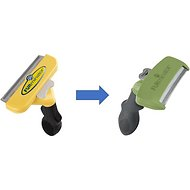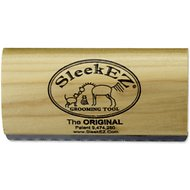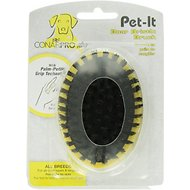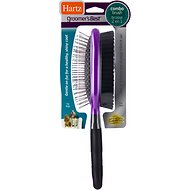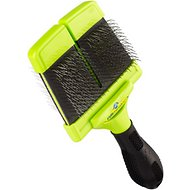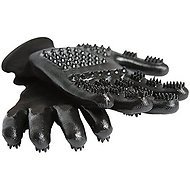10 Best Dog Brushes: Our Top Rated 2025 Picks
Quick Guide
A dog brush is an essential tool for keeping your dog’s coat looking great, avoiding tangles and matting, and ensuring that you keep shedding around your home or apartment to a minimum.
But dog brushes are not “one size fits all.” Each pup is different – and different coats require different brushes! If you’re confused and not sure where to start when it comes to dog brushes, coats, and the best dog brushes on the market, you’re in the right place.
In this article, we’ll be taking a deep look at the best dog brushes on the market, and we’ll also explain some key grooming concepts that are sure to help you take better care of your precious pup. Let’s get started now!
What is the Best Dog Brush?
Different Types Of Dog Brushes
There are many different types of dog brushes. The particular set of brushes you’ll need to groom your dog properly will depend on its coat, how dirty it tends to get, the health of its skin and fur, and a number of other factors. Let’s go over the major types of dog brushes now.
- Deshedding tool – Deshedding tools are primarily used for long haired dogs and dogs with double coats. Using a long, sturdy stainless steel edge with a toothed design, these tools are made to reach through the top coat of fur into the undercoat, and remove loose hair from the undercoat – which is often the biggest culprit of excessive shedding. These tools are ideal for long-haired dogs and double-coated dogs.
- Slicker brush – Slicker brushes use a series of fine, close-together wires which are woven together on a flat surface. The tightly-spaced wires are used to help break apart clumps and mats in the fur. Usually, they are used on curly, wiry, or medium-to-long-haired dogs, but can be used to address matting and clumping on just about any dog breed. You must be gentle when using a slicker brush, though, or you could tear your dog’s fur and skin.
- Comb – Dog combs come in a variety of sizes, and can be used for everything from basic grooming to deshedding and eliminating mats and tangles. They are very portable due to their small size, but not ideal for prolonged grooming sessions. We recommend carrying dog combs for on-the-go grooming – like removing tangles and mats caused by mud when on a hike or a walk.
- Pin brush – Pin brushes will look familiar to you, as they are very similar to the hair brushes used by people, with an oval-shaped design and a loosely-arranged set of flexible wires, topped with pins. Most pet owners use pin brushes as the final step of their grooming procedure, to catch any loose hair that may have been missed, and provide their dogs with a final “fluff” of their coat.
- Rake – Rakes are specifically designed for double coat dogs with a thick coat and undercoat, like German Shepherds, Malamutes and Huskies. They are shaped similarly to a razor, using one or two rows of pins, and designed to penetrate through the top coat to remove dead undercoat material, debris, and tangles. Care should be taken to select a rake with pins that are a similar length to your dog’s fur. If the pins are too short, they won’t reach the undercoat. If they’re too long, they could rub against and irritate the skin.
- Bristle brush – Bristle brushes are ideal for dogs with a smooth coat and short hair, like Jack Russell Terriers and Italian greyhounds. Using clumps of tightly-packed, natural bristles, these brushes help remove any loose hair and stimulate the skin while minimizing irritation, leading to a healthier coat.
- Glove – Glove brushes usually use rubber tips and pins, on a rubber glove. They are useful for grooming anxious dogs, because they allow you to remove clumps and dead hair while just “petting” your dog, instead of using a brush. They’re not as effective as purpose-built brushes, but are useful tools for a quick brush or rub-down for your pup.
Different Types Of Common Dog Hair Coats
The proper type of brush for your dog will depend, in part, on its coat. Different breeds of dog have different coats – from the smooth, short fur of a Jack Russell Terrier, to the more curly, wiry coats coat of a labradoodle or terrier. Here’s a quick list of the 5 most common types of dog hair coats.
- Smooth coat – A smooth coat usually requires the least amount of grooming, as it’s the shortest and most simple type of coat to care for. The hair is short and lies very close to the body, making the dog feel very smooth to the touch – hence the name. A few common breeds with a smooth coat include short-haired Dachshunds, short-haired chihuahuas, beagles, bulldogs, and Great Danes, to name a few.
- Double coat – Dogs with a double coat can be either short-haired or long-haired. Underneath their primary layer of fur, there is a softer, dense “undercoat’ which helps provide insulation, repel water, and shield the skin from dirt. As you can imagine, a double coat means you’ll need to spend more time grooming your dog, as there is much more hair to take care of!
- Wire coat – A wire coat consists of wiry, thick fur that tends to become matted and tangled. Most terriers have a wire coat, as do Irish wolfhounds. Wire coats require a lot of upkeep to prevent them from becoming tangled.
- Long coat – Dogs with a long coat can have a single coat of fur, like some kinds of long-haired chihuahua, or they can have a double coat, like a German shepherd. Long coats are either coarse or silky, and require a lot of upkeep, compared to shorter coats.
- Curly coat – Not to be confused with a wire coat, a curly coat is wavy and curly, but soft and typically curls close to the body. Curly-coated dog coats are usually trimmed short, to avoid tangles and mats.
Depending on your dog and its coat, you may need a variety of different brushes – as outlined above. Ready to start shopping? See our top rated 2025 picks for the best dog brushes below.
Overall Best Dog Brush
| Our 2025 Picks: Best Shampoo for Cats with Lice | |||
FURminator DeShedding Edge Dog Brush
|
CHECK PRICE | ||
SleekEZ Deshedding Grooming Tool
|
CHECK PRICE | ||
Safari Self-Cleaning Slicker Brush For Dogs
|
CHECK PRICE | ||
Andis Steel Pet Comb
|
CHECK PRICE | ||
Oster Combination 2-In-1 Dog Brush
|
CHECK PRICE | ||
JW Pet Gripsoft Double Row Undercoat Rake
|
CHECK PRICE | ||
ConairPRO Pet-It Boar Bristle Brush
|
CHECK PRICE | ||
Hartz Groomer’s Best Combo Dog Brush
|
CHECK PRICE | ||
KONG Dog ZoomGroom Multi-Use Brush
|
CHECK PRICE | ||
FURminator Firm Slicker Brush For Dogs
|
CHECK PRICE | ||
HandsOn All-In-One Bathing & Grooming Glove
|
CHECK PRICE | ||
FURminator deShedding Edge Dog Brush
Overall Best Dog Brush: If you choose only one dog brush from this list, the FURminator deShedding Edge Dog Brush is a great option, particularly for long-haired dogs with thick undercoats.
It’s been proven to help reduce shedding by up to 90%, and it comes in three sizes, with two different lengths for short-haired and long-haired dogs. The sturdy, ergonomic handle supports a strong, stainless steel blade, with a skin guard that prevents irritation from the brushing process, and a unique FurEjector button helps you easily remove clumped hair and fur, and keep the brush clean.
- Pros: Comes in a variety of sizes, sturdy construction, incredibly easy to use, won’t damage topcoat or skin
- Cons: On the pricey side, not useful for dogs without an undercoat, takes a long time to groom your dog properly
SleekEZ Deshedding Grooming Tool
Best Deshedding Tool for Dogs: If you need a purpose-built deshedding tool, this product from SleekEz is definitely your best bet. It’s usable on dogs with every type of coat, except for those with extremely long hair, and has a sturdy metal blade and a durable, thick wood handle that allows you to provide even, gentle pressure to remove loose topcoat hairs and brush the undercoat.
The unique, toothed design also helps remove dirt, dust and dander, keeping your dog’s coat bright and beautiful. It can even be used to remove dog hair from upholstery, carpet and more, making it a very versatile product.
- Pros: Usable on all dogs except extremely long-haired breeds, can be used outdoors, removes excessive dirt and dander
- Cons: Can’t be used for detangling, relatively short blade, not as effective for dogs with both a long top coat and thick undercoat
Safari Self-Cleaning Slicker Brush for Dogs
Best Slicker Brush for Dogs: A slicker brush is the best tool to remove and treat mats and clumps on dogs of any breed and coat type, and this product from Safari is the best on the market.
It uses hundreds of extremely thin pins, and has a retractable design that retracts the pins, and allows you to extract dog hair in seconds. The stainless steel pins are durable yet gentle, and the comfortable rubber handle is easy to maneuver and hold, even for extended grooming sessions.
- Pros: Usable on all dog breeds, quickly removes tangles and mats, easy to dispose of dog hair
- Cons: Excessive pressure can cause skin irritation and cause wires to bend, tips are not cushioned
Andis Steel Pet Comb
Best Dog Comb: If you’re looking for a tool to help keep your dog’s coat clean while you’re on the go, the Andis Steel Pet Comb is a great option. It’s built with a two-sided design, incorporating both wide stainless steel teeth for untangling mats, and narrow teeth for thin coats and sensitive areas.
It’s an ideal finishing tool for brushing sensitive face areas and fluffing the coat after a bath, and for smoothing out tangles while you’re out and about with your dog.
- Pros: Double-sided design, rounded and durable stainless steel teeth, available in both 7.25 and 10 inch sizes
- Cons: Not comfortable to use for prolonged grooming sessions, large design is not ideal for smaller breeds
Oster Combination 2-in-1 Dog Brush
Best Pin Brush for Dogs: A pin brush is the ideal tool to use when finishing a grooming session with your pup, or just to remove some of its loose fur whenever you feel like giving it a quick brush! One one side, this Oster combination brush features strong metal pin with ball tips for enhanced comfort, and to remove both topcoat and undercoat hair.
On the other side is a gentle, soft bristle brush, which helps stimulate oil production in your pups, and is ideal for dogs with smooth, thin coats. The ergonomic handle makes it easy to hold and use, and the medium-sized brush head makes it useful for dogs of all shapes and sizes.
- Pros: 2-in-1 design offers great value, gentle pin design eliminates skin irritation, holds hair securely after brushing
- Cons: Not designed for thick, double-coated dogs, some customers report pins bending after prolonged use
JW Pet Gripsoft Double Row Undercoat Rake
Best Rake for Dogs: For dogs with thick undercoats, such as retrievers and German shepherds, this undercoat rake from JW Pet Gripsoft is an ideal choice. With two rows of metal teeth in different lengths, it gently lifts shedding hair from the undercoat and holds it securely in place. An ergonomic handle and medium size makes it easy to handle, and usable on almost any breed of dog.
- Pros: Quickly removes loose undercoat fur, holds loose fur securely, the double layer of teeth ensures even coverage
- Cons: Teeth are too short for some long-haired dogs, design is too large for some breeds of small and toy dogs
ConairPRO Pet-It Boar Bristle Brush
Best Bristle Brush for Dogs: Bristle brushes are ideal for regular grooming of short-haired dogs without an undercoat, and can be used on dogs of all breeds to stimulate the production of oil and keep the coat shiny.
This brush from ConairPRO is made with natural, soft boar bristles combined with a synthetic material, which keeps your dog comfortable, and has a unique, contoured handle to give you plenty of control when brushing.
- Pros: Soft brushes are comfortable for even the most sensitive dogs, unique “palm grip” design, ideal for short and curly coats
- Cons: Won’t remove undercoat fur, small design is difficult to use for large or giant breed dogs, less effective on long-haired dogs like retrievers
4 More Top Rated Brushes for Dogs
Want to explore some more options for brushing your dog? These below brushes didn’t quite make our “top rated” list, but are still a great value, and may be right for you and your pup. Take a look now!
Hartz Groomer’s Best Combo Dog Brush
This brush combines a stainless steel pin brush with rounded tips, and a nylon bristle brush into a single, low-cost unit, making it a great value if you’re on a tight budget. With an ergonomic plastic handle, durable design, and a medium-sized, oval design, it can be used on just about any dog breed.
- Pros: Low cost, offers great value due to 2-in-1 design, pins are rounded for greater comfort
- Cons: Bristle brush is 100% nylon with no natural materials, not ideal for thick, double-coated breeds
KONG Dog ZoomGroom Multi-Use Brush
This product from KONG uses a rubber design with a number of massaging rubber “pins” that help remove loose fur and massage your dog at the same time. The teeth are spaced widely to ensure it moves through the fur without pulling or irritation, and the rubber material pulls in hair like a magnet, and is easy to clean. It can even be used to spread shampoo when bathing your dog, to help break up clumps and mats.
- Pros: Inexpensive, rubber is easy to handle with wet hands, gentle and won’t pull dog hair
- Cons: Not useful for detangling and serious mats, dogs may chew and destroy the product due to its all-rubber design
FURminator Firm Slicker Brush For Dogs
This slicker brush from FURminator has a flexible head and a unique design that features curved bristles on one side, and straight bristles on the other, which helps hook onto the undercoat and remove loose hair quickly. A large, ergonomic handle makes it easy to use, and the flexible head follows the contours of your dog’s body to remove hair more effectively.
- Pros: Unique dual-bristle design, flexible head, antimicrobial plastic design
- Cons: Too large for some dog breeds, not useful for most short-haired breeds, sharp bristles could irritate your dog’s skin if too much pressure is applied
HandsOn All-In-One Bathing & Grooming Glove
This grooming glove is perfect if you need to break up clumps and mats in your dog’s fur. The unique design helps spread shampoo and conditioner when you’re rubbing it into your dog’s fur and skin, and gently work through mats and clumps, with a massaging action. When dry, they can also be used to quickly remove loose fur and reduce shedding.
- Pros: Non Slip and easy to use when wet, soft enough to use on the face and ears, gentle massaging action feels great for your dog
- Cons: Hair does not stay on the gloves and tends to fall to the floor, not usable for dogs with wiry coats, gloves tend to run a bit small
Our Guide To Properly Brushing Your Dog – 7 Steps To Success
So, you’ve found the perfect tools for brushing your pup. Now, how can you use them properly to ensure your dog’s coat looks healthy and beautiful? Here are a few tips you can use to brush your dog properly.
- Brush your dog at least once per week – This is especially important for long-haired, double-coated, curly, and wiry dog coats. If you have a dog with short, single-coated fur, you may not need to brush every week – but it’s still a good idea to help prevent excessive shedding and dander. Brushing your dog at least once per week will keep their coat healthy, and provide you with a great time to bond with your pup.
- Start from the face, moving toward the rear – Brushing dog hair on the face and neck is often a bit uncomfortable for your pup, so we recommend beginning with this step, as they’ll still be feeling patient at the beginning of the grooming session. Then, work your way from the face and neck toward the rear.
- Brush in the direction of the dog’s coat – You want to brush “down and out,” away from the dog’s skin, and in the direction that their coat naturally grows. Going against the grain doesn’t feel good for your pup, and may make it irritable.
- Always use minimal pressure – This is particularly important when trying to remove tangles or mats. Be as gentle as you can. Excessive pressure can irritate or damage the skin, or even rip out some of your dog’s hair. Be as gentle as you can, and only increase the pressure you’re using when you really need to.
- Use the right tool(s) for the job – Depending on your dog, you may need a rake, bristle brush, deshedding tool, a slicker brush, and more. There’s no such thing as a single “one-size-fits-all” brush, so make sure you invest in the right brush for your dog’s coat.
- Use a conditioner or mat spray to remove tangles, mats – When you run into a serious tangle or mat, you should use mat spray or dog hair conditioner to soak the area, and help loosen and relax the mat. Don’t just try to pull on it while it’s dry. If you do this several times and can’t remove the tangle or mat, you may want to take your pup to a groomer, or consider simply shaving the area to remove it, if possible.
- Take breaks, if you need to – It may take more than 30 minutes to brush a long-haired dog. You don’t have to brush your dog all at once. Consider giving it a break every few minutes if it seems like it’s getting restless, so that it doesn’t get uncomfortable or anxious. Then, just pick up where you left off!
- With the right tools, the right mindset, and the right tips, you’ll be able to do a great job of maintaining your dog’s coat – and save money by avoiding professional grooming! So follow the above steps, and keep your pup happy and healthy.
The Top 5 FAQs About Brushing Your Dog
Still got more questions about brushing your dog? We’ve put together a few of the most common FAQs related to dog grooming and brushing below – check them out, and get the answers you need.
- Does regular brushing really help with shedding? Yes. In fact, brushing your dog regularly is the single best thing you can do to help prevent excessive shedding in your home. Rather than just waiting until dead fur is shed by your dog naturally, you’re brushing it away and containing it. If you brush your dog once a week or more, you’ll notice a significant reduction in loose pet hair and dander around your home if you maintain a consistent routine.
- Do I still need to go to the groomer if I brush my dog? Use your best judgment. In some cases, your dog may still need to see a professional groomer – if you go on a hike and it gets a ton of mud in its fur and develops serious mats, for example. If you don’t feel confident in your ability to remove mats and tangles from your dog without hurting it, a professional groomer may be able to help.
- How can I make my dog less anxious during brushing and grooming? If your dog tends to become nervous and anxious when you’re grooming it, the first thing you’ll want to do – counterintuitively – is brush it more often. Even if you just do a few short, minute-long brushing and grooming sessions, your dog will become more desensitized to the process, and be less anxious.
You can also consider brushing your dog while it’s eating. It will be distracted while it munches on its kibble – providing you with a great time to take on a quick brushing session. We also recommend rewarding your dog with treats every time you brush it – it will then start to associate the sensation of brushing with treats, and will stay calmer during the process.
Finally, you should go slow when grooming, and start out as gently as possible, using a non-invasive brush at the start of the brushing session to desensitize your dog. Then, you can move onto tools like rakes and deshedding tools after your pup has gotten used to the feeling of the brush. - Should I brush my dog when I give it a bath? Yes! Brushing your dog after a bath is an ideal opportunity to remove dirt, dander and dead fur. As a matter of fact, you should brush your dog both before and after you give it a bath. Brushing before helps remove fur that’s easy to brush out, and will help you locate any knots, tangles or mats that you may want to work on with soap.
Then, you can brush your dog after its fur is dry. If your dog doesn’t mind a blow dryer, you can usually do this right after you finish bathing it – otherwise, you should wait a day or two to brush it after its bath. Brushing wet dog hair is never a good idea, and can lead to pulling, tangles and mats. - Does brushing my dog help it stay cool in hot weather? To an extent, yes. Brushing a dog with a double coat in the spring or summer, for example, can help remove some of its dense undercoat, which tends to grow more thickly in the winter. This, in turn, can help your pup stay a bit cooler in the summer heat. Removing mats and clumps of dog hair can also help ensure an even coat, which keeps your dog stay a bit cooler.
Still, though, you should make sure you understand your dog’s heat tolerance. Cold-climate dogs like Malamutes or Huskies should be treated with care in the summer, to ensure they don’t overheat.
We hope these answers have been helpful – and assisted you as you prepare to take on the job of brushing and grooming your dog on your own!
Conclusion
We hope this comprehensive guide has been helpful, and assisted you in picking out the right products for grooming your dog. We’ve tested these products and found them to be the best on the market, so each one is a great option for grooming your pooch.
Each dog is different, so if you’re still confused or not sure that you’re brushing your dog properly, we’d recommend consulting your veterinarian or dog groomer for more details.


